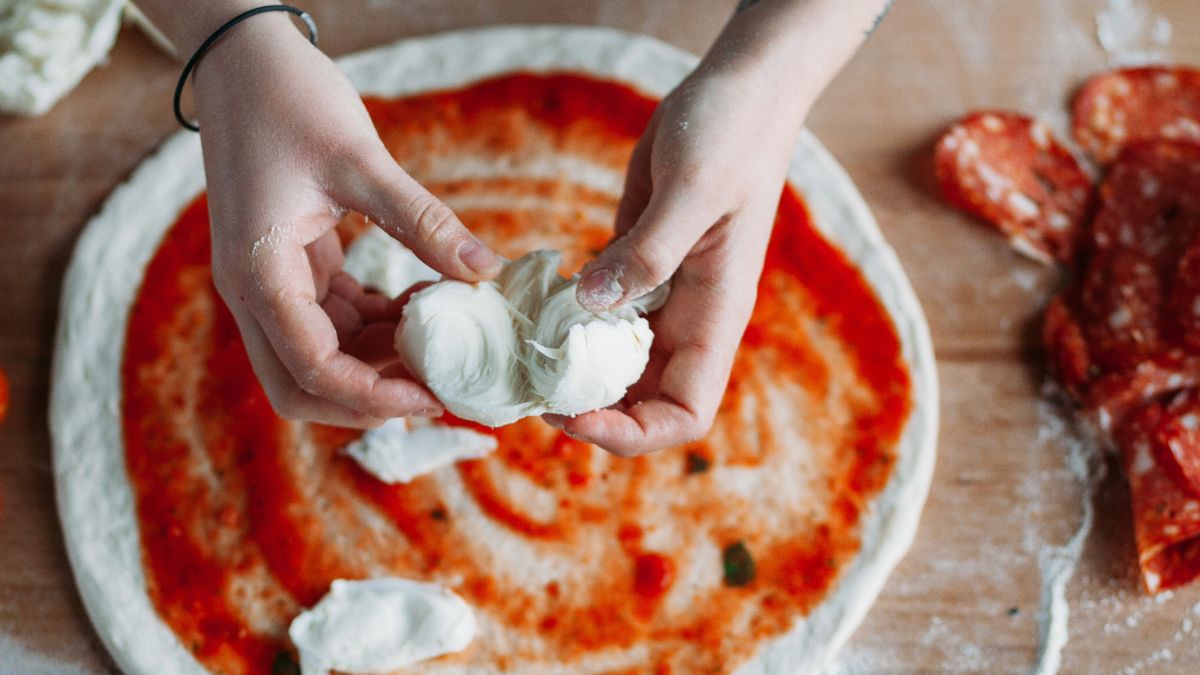Who can resist a traditional Neapolitan pizza?
Neapolitan pizza, an iconic emblem of Italy's gastronomic prowess, has captivated the hearts and palates of food enthusiasts worldwide. This pizza, which hails from the vibrant city of Naples, stands as a testament to the Italian tradition of culinary simplicity and excellence.
The goal of this blog post is to delve into the delicious world of Neapolitan pizza, unraveling its unique defining characteristics and timeless allure. We will also guide you through a step-by-step process on how to prepare authentic Neapolitan pizza dough at home, transforming your kitchen into a slice of Naples.
The Origins of Neapolitan Pizza
The popularity of Neapolitan pizza stretches far and wide, transcending borders and cultures. It's not just another pizza style; it's a beloved masterpiece savored across the globe.
Originating in the streets of Naples, this pizza has traveled from the vibrant Italian neighborhoods to the bustling cities of New York, Tokyo, and beyond. It's a testament to how a simple combination of fresh ingredients can create something universally cherished. The charm of true Neapolitan pizza lies in its authentic taste and the traditional method of preparation, making it a favorite among connoisseurs and casual diners alike.
Raffaele Esposito is a historical figure closely associated with the creation and popularization of Neapolitan pizza. He was an Italian pizzaiolo (pizza maker) who worked at the Pizzeria Brandi in Naples, Italy, during the late 19th century. In 1889, Raffaele Esposito and his wife, Maria Giovanna Brandi, had the honor of preparing pizzas for the visit of King Umberto I and Queen Margherita of Savoy.
The story goes that to honor the royal visit, Raffaele created a special pizza with patriotic ingredients to represent the colors of the Italian flag: red tomatoes, white mozzarella cheese, and green basil. This pizza, known as the "Pizza Margherita," is now considered a classic Neapolitan pizza style and is often cited as one of the earliest examples of this iconic Italian dish.

Raffaele Esposito's contribution to the history of pizza is significant, as he played a role in popularizing Neapolitan pizza and showcasing it to the world, especially with the Pizza Margherita, which has become an enduring symbol of Italy's culinary heritage. His legacy lives on as Neapolitan pizza continues to be celebrated and enjoyed globally.
New York-style pizza, along with various other regional pizza styles, can be traced back to the traditional Neapolitan pizza. Neapolitan pizza, with its thin, soft, and slightly chewy crust, was introduced to the United States by Italian immigrants in the late 19th and early 20th centuries. Over time, as it made its way to New York City, this classic Italian dish underwent a culinary transformation. New Yorkers adapted Neapolitan pizza to suit local tastes and available ingredients, resulting in the iconic New York-style pizza characterized by its large, foldable slices and a balance of flavors.
Similarly, other regional pizza styles across the United States, such as Chicago's deep-dish pizza and Detroit's square pan pizza, have their roots in Neapolitan pizza but have evolved into distinct variations that reflect the culinary preferences and available resources of their respective regions. Thus, the Neapolitan pizza tradition serves as the cornerstone upon which America's diverse and beloved pizza landscape was built.
How is Making a Neapolitan Pizza Different Than Making Other Pizzas?
The process of making Neapolitan-style pizza differs considerably from preparing other types of pizzas. The uniqueness lies in its traditional methods and stringent rules, adhering to centuries-old Italian techniques that elevate it beyond the ordinary pizza. A few distinguishing factors include:
- The Dough: Unlike other pizzas where commercial yeast is often used, Neapolitan pizza dough calls for natural yeast or sourdough. The dough is then left to rise for a minimum of 8 hours and up to 24 hours. This slow fermentation contributes significantly to the flavor and texture.
- The Technique: The dough for a classic Neapolitan pizza is hand-stretched and not rolled with a rolling pin like many other pizza types. This technique preserves the dough's gas bubbles and results in the characteristic airy and puffy crust.
- The Sauce: Authentic Neapolitan pizza showcases a simple yet flavorful sauce made from ripe San Marzano tomatoes, which grow in the volcanic soil of Mount Vesuvius. The sauce is usually uncooked and applied in a circular motion from the center of the dough outwards, leaving a border for the crust.
- The Toppings: The insistence on using authentic, high-quality Italian ingredients sets Neapolitan style pizza apart. The preferred cheese is Mozzarella di Bufala, made from the milk of Italian water buffaloes, or Fior di Latte, a cow's milk mozzarella.The crowning glory of a Neapolitan pizza is fresh basil leaves, adding a fragrant burst of flavor. These ingredients, forming the colors of the Italian flag, are not common in other varieties of pizza, making the Neapolitan type a unique culinary experience.
- The Oven: Neapolitan pizza is strictly baked in a blazing hot, wood-fired, dome-shaped oven, which is a rarity among other pizza types. The oven's high temperature (800°F or more) and the wood fuel contribute to the pizza's unique flavor and charred crust. This quick, high-heat process gives the pizza its characteristic blistered, slightly charred crust.
- The Cooking Time: Neapolitan pizzas cook incredibly quickly due to the high oven temperatures. The cooking time is typically 90 seconds, much shorter than other types of pizza.
This meticulous process and the use of high-quality ingredients embody the essence of Neapolitan pizza. It's not just about the taste, but the experience and tradition that each bite encapsulates.
Each of these elements results in a pizza that is distinctly Neapolitan, offering a taste and texture that stands out from other pizzas. The strict adherence to these traditional methods of preparation is what has earned Neapolitan pizza the coveted DOP (Denominazione d'Origine Protetta) status, recognizing its cultural and culinary importance.

Choosing the Right Flour and Starter for Neapolitan Pizza Dough
One of the secrets behind the charm of an authentic Neapolitan pizza lies in the choice of flour and starter. When it comes to flour, 'Tipo 00' is the gold standard for making Neapolitan pizza dough. This Italian milled flour is exceptionally fine and high in gluten, which allows the dough to stretch thinly without tearing. It also contributes to a tender yet crisp crust, a hallmark of Neapolitan pizza.
As for the starter, many traditionalists prefer natural yeast or a sourdough starter over commercial yeast. Utilizing a sourdough starter is a time-honored method that can provide your dough with a deep, complex flavor and subtle tanginess. It also enhances the texture, giving your crust that coveted airy, bubbled edge. However, working with a sourdough starter requires patience and practice, as it takes more time to rise compared to commercial yeast.
Remember, whether you choose 'Tipo 00' flour or a sourdough starter, the key is consistency and patience. Conquering the art of pizza dough making is a journey, and each step you take brings you closer to that perfect traditional Neapolitan pizza.
Sourdough Neapolitan Pizza Dough Recipe
Transforming your kitchen into a Neapolitan pizzeria is a delightful journey, and it begins with crafting the perfect base: the pizza dough. For this recipe, we'll be using a sourdough starter, which imparts a complex flavor profile and a lovely, chewy texture to your pizza crust.
Ingredients:
- 500 grams of '00' pizza flour (3 3/4 cups)
- 350 grams of water (1.5 cups)
- 150 grams of active sourdough starter (approx. 1 cup)
- 10 grams of salt (approx. 1 2/3 tsp)
- A drizzle of olive oil
Step 1: Preparing the Dough
- Mix: In a large bowl, combine the flour and the water until a rough dough forms.
- Add Starter: Incorporate the active sourdough starter into the mixture. Mix until well combined.
- Add Salt: Add the salt. Mix until incorporated into dough.
- Rest: Rest this mixture for about 20 minutes to hydrate the flour thoroughly.
- Knead: Knead the dough on a lightly floured surface for about 10 minutes or until it becomes smooth and elastic.
- Bulk Fermentation: Transfer the dough to a lightly oiled bowl. Cover the bowl with a damp cloth and let the dough rest at room temperature for 2-4 hours.
- Divide and Shape: Divide the dough into four equal portions. Shape each portion into a ball, cover, and let them rest for an additional 8-24 hours in the refrigerator for final proofing.
Step 2: Prepping the Ingredients
- Crush San Marzano tomatoes by hand to create a chunky sauce. No cooking is needed.
- Slice Mozzarella di Bufala or Fiore di Latte into thin pieces.
- Hand tear fresh basil leaves.
Step 3: Shaping the Pizza
- Preheat your oven to its maximum temperature. If you have a pizza stone, place it in the oven.
- Take one of your dough balls and begin to stretch it from the center to the edges, leaving a slightly thicker crust around the rim.
- Be gentle to preserve the air bubbles in the dough. Avoid using a rolling pin as it could deflate the dough.
Step 4: Assembling the Pizza
- Spread a thin layer of the crushed San Marzano tomatoes over the stretched dough.
- Add slices of buffalo mozzarella, leaving some spaces in between.
- Drizzle a little extra virgin olive oil on top.
Step 5: Baking the Pizza
- If you have a pizza peel, use it to transfer the pizza onto the preheated pizza stone in the oven. If using a traditional pizza oven, you will typically cook directly on the floor of your oven.
- Bake at the highest temperature until the crust is puffed up and slightly charred. This could be 60-90 seconds in a wood-burning oven or several minutes in a regular oven.
- Keep a close eye on the pizza as it cooks pretty quickly.
Step 6: Serving the Pizza
- Once out of the oven, add the fresh basil leaves.
- Let it cool slightly before slicing.
- Enjoy your homemade Neapolitan pizza, a masterpiece of Italian tradition in the comfort of your home.
Bear in mind that while this guide is simplified for home cooks, the key to a great Neapolitan pizza lies in attention to detail, the quality of the ingredients, and the love you put into making it. Mastering the art of sourdough pizza dough takes time and practice. Don't be disheartened if your first few tries are not perfect. Each attempt brings you closer to achieving your ideal sourdough Neapolitan pizza. Enjoy the process!
Serving Neapolitan Pizza
When it comes to serving your homemade Neapolitan pizza, presentation is key. Place the pizza on a large wooden board or a preheated pizza stone to retain its temperature. A fresh sprinkle of basil leaves or a drizzle of extra-virgin olive oil just before serving can add a vibrant touch.
To keep the authentic Neapolitan pizza experience, cut the pizza into four large slices using a pizza wheel. This way, each slice can be folded in half, as per Neapolitan tradition, and enjoyed to the fullest. Remember, the charm of a homemade Neapolitan pizza lies not only in its taste but also in the overall experience; it's a culinary journey to the heart of Italy, right from your kitchen.

What To Drink With Neapolitan Pizza
Pairing your homemade Neapolitan pizza with the right beverage can elevate your dining experience to new heights. If you're a wine enthusiast, an Italian red, such as a light and fruity Chianti or a smooth Primitivo, can complement the rich tomato sauce and creamy mozzarella.
For white wine lovers, a crisp Vermentino or a refreshing Fiano might do the trick. These wines possess the acidity needed to cut through the richness of the cheese and the sweetness of the tomatoes.
If you lean towards beer, opt for a craft lager or pilsner. Their lightness won't overpower the pizza's flavors, while their crisp finish will cleanse your palate between bites. For non-alcoholic options, consider an Italian soda or a sparkling water to provide a refreshing contrast to the pizza's richness.
Common Mistakes and How to Avoid Them
Making real Neapolitan pizza at home can be an exciting yet intimidating endeavor, especially for novices. Here are some of the common mistakes you might encounter, along with tips to help you overcome these challenges:
- Not Letting the Dough Rise Enough: Patience is key when it comes to making Neapolitan pizza dough. Failure to allow the dough to rise for an adequate amount of time can result in a dense and heavy crust, rather than the light and airy texture that is the hallmark of Neapolitan pizza. Tip: Be patient and allow the dough to rise for at least 8 hours, if not longer.
- Overloading the Pizza with Toppings: While it’s tempting to add a mountain of toppings, doing so can make your pizza soggy and difficult to cook properly. Neapolitan pizza is appreciated for its simplicity and balance of flavors. Tip: Stick to the essentials – tomatoes, fresh mozzarella cheese, olive oil, and basil. Less is more in this case.
- Not Using a Pizza Stone or Steel: Attempting to bake your pizza on a regular baking sheet can lead to a crust that’s not properly cooked. Tip: Invest in a pizza stone or steel that mimics the effect of a wood-fired oven, achieving that desired crispy bottom.
- Incorrect Oven Temperature: Neapolitan pizza requires a very hot oven. If the temperature is too low, you won't achieve the characteristic char on the crust. Tip: Preheat your oven to its maximum temperature, ideally with a pizza stone or steel inside.
- Mismanaging the Dough: Overworking your dough or using a rolling pin can result in a flat and dense crust, losing the airy, bubbled edge that makes Neapolitan pizza so special. Tip: Learn to gently hand-stretch your dough, preserving its natural structure.
Remember, practice makes perfect. Don't be disheartened by initial hiccups; each attempt brings you one step closer to creating your perfect Neapolitan pizza at home.
The art of making Neapolitan pizza at home is a blend of patience, simplicity, and authenticity - from the careful preparation of dough with just four staple ingredients, to the meticulous hand-stretching, and the thoughtful assembly of San Marzano tomatoes, fresh mozzarella, and fragrant basil leaves. It's a journey that extends beyond the realm of cooking, offering an immersive experience steeped in tradition, culture, and passion. Each slice embodies the heart of Naples and the expertise of generations of pizzaiolos.
As you venture into making your own Neapolitan pizza at home, remember that perfection lies in practice and the joy of cooking is in its process. Embrace each step, relish each bite, and share your culinary journey with others.
Whether you're a novice or an experienced cook, we encourage you to roll up your sleeves, dust off your pizza stone, and embark on your Neapolitan pizza adventure. We can't wait to hear about your homemade pizza triumphs. Buon appetito!




